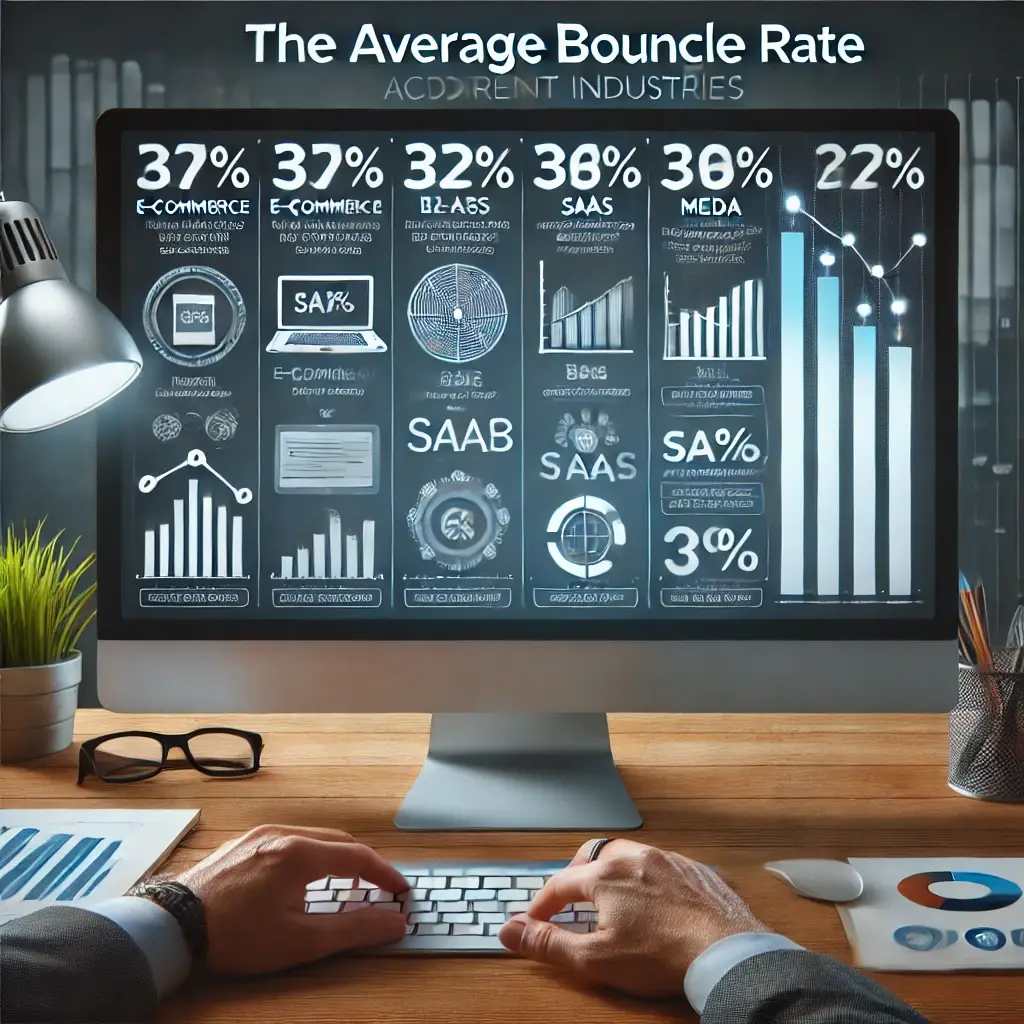Learn the meaning of one of the most important metrics when evaluating site traffic and interaction
Bounce Rate or Bounce Rate is the percentage of visitors who access a site and leave without accessing new pages or interacting with your content, making just a page display. The higher the bounce rate, the worse the interaction of visitors.
“Bounce Rate” is a term that, by itself, scares many people who never had a closer contact with Web Analytics.
Despite the fact that there is confusion and that many do not in fact understand what it represents, this is a very important metric to evaluate the effectiveness of the actions of Digital Marketing and a great input to know what to optimize, where to optimize and how to optimize.
What is the average bounce rate for a company. In this post, you will discover what the rate of overflow is, how it is measured, why it happens and even tips to decrease it.
What does Rebound Rate mean
The rebound rate, or Bounce Rate, is a number expressed as a percentage that indicates how many visitors accessed a single one of your company’s site and immediately left, without continuing browsing on a next page. Every time that happens, a bounce is counted.
This definition is not absolute and can vary from tool to tool. However, it is the form used by the most widely used system in Web Analytics in the world, Google Analytics.

It is important not to confuse bounce rate with output rate. Both have different meanings and impacts. The bounce rate occurs only when a person accesses just one page of the site. The saalid rate is a metric to show how many people are leaving the site from a certain page, regardless of whether or not it is the first page visited on the site.
Why it is important to monitor the Bounce Rate
All companies must have specific objectives on their sites. It can be the download of a material, a budget request, the record of newsletter or the purchase itself in the case of e-commerce. And normally achieving that goal requires at least one click, which means that when there is a bounce, among other things, the site failed to drive the visitor to the target.
By monitoring the rebound rate, your company manages to obtain information on the effectiveness of calls to action and the message, for example, to think of optimizations and improvement plans to reduce rebound and possibly increase conversion.
In the case of traffic from Google Ads, the rebound rate is even more worrying, as a high rate means money wasted on clicks and consequently an increase in Lead Cost (CPL).
Also, Google Ads now considers the bounce rate in calculating the ad quality index, that is, the higher the bounce rate from the ad landing page, the lower the quality index and the higher the cost per click of the campaign.
How to measure the rebound rate?
Many people often see the rebound rate of the site as a whole. The problem is that this number does not show in detail where the problem is and, for that reason, it is difficult to think of corrective actions.
To better understand the rebound rate of the site, a more detailed analysis is necessary, such as those mentioned below.
Rebound Rate of Third Party Links
At this point, it is interesting to individually measure the bounce rate of the main sites that carry traffic for your company.
You generally see that some sources perform much better than others. For underperforming sources, it is worth analyzing in depth why that is happening, what page receives those visits, and what Call to Action you use, etc.
Depending on the case, it is even possible to contact the blog or site that has the link and ask them for a modification, for example.
Keyword Bounce Rate
If your company is committed to creating content to generate traffic for the site or blog, then you should be concerned with the performance of the keywords that generate traffic on the site.
When we speak in keywords, we are not limited only to organic searches, but also to paid searches such as Google Ads, for example.
Both forms are worth analyzing and, apart from that analysis, making specific actions to reduce the rebound rate of the most important words.
There are several actions that can be performed to decrease the bounce rate per keyword. One of them is to do A / B tests on your Landing Pages to find out if there are any elements that are limiting the conversion and, as a consequence, increasing the rebound rate.
Another idea is to see if the pages that visitors reach via organic search are with good content and good Calls to Action, as well as if they have content appropriate to what the target audience is looking for.
Bounce rate of the most visited pages
At rebound rate it must also be analyzed for each of the most visited pages on your company’s site.
By doing this exercise, it is possible to perceive that there are pages with a lot of traffic and a high percentage of rebound, which ends up decreasing the value of those pages.
If the most important pages of your company present a high percentage of rebound, it is worth reviewing them to see if the content is suitable for the public, if the offer (call-to-action) is attractive and makes sense or even perform A / B tests with the intention of improving the metric.
Blog Rebound Rate
In the case of blogs, you should be careful when analyzing the bounce rate. Many people visit the blog periodically to read the last article and immediately leave, which does not mean that they did not like the page. They just already know and follow the blog.
To make a correct analysis of the bounce rate of a blog, then, the bounce rate of new visitors must be analyzed, that is, those who never visited the blog before.
If that were a high rate, further investigation is necessary to discover if the Calls to Action are not being effective, if the words that are bringing traffic are well related to the content and if there is also an opportunity to take advantage of them for the generation of content on the blog.
You may also want to read… “How to use social media to promote your business“
How to reduce the bounce rate of blogs
And when is that rate too high compared to your new visitors? What should we do? Here are 5 tips to help you reduce this metric and further improve your blog.
one. Create a good structure for your text
Make your content short paragraphs: avoid more than seven lines in each one. Think that your user needs a text with solid ideas. To do this, create subtitles and a line of continuity in each topic.
Also, you can use bullets, like the ones we use below:
- They are a good visual aid.
- They help to better explain the subject.
- Order the ideas you want to convey.
2. Use internal links in your post
If you have content that can give your post more depth or even continue on points you don’t intend to talk about in the text, creating internal links can be a good solution.
A tip: leave the command in the link to open it in a new tab. Therefore, the visitor to your website does not need to leave the current publication to go to the next publication, does not lose focus on reading and can still go further in its subject.
3. Insert CTAs (Calls-to-Action) on your website
One of the main foci of the Inbound Marketing is to generate Leads, both for relationships and for sales. Therefore, it is necessary to encourage your visitor to become Lead through conversions, that is, to have the visitor fill out a form to leave their information in exchange for educational material, a test request, contact, etc.
And, to generate this incentive, it is recommended to use a CTA that, in addition to meeting this objective, makes the visitor collaborate with the reduction of the bounce rate on their blog, since the CTA will take the visitor to another page, where will fill out the form.
4. Do not show everything in the index (initial page)
When it comes to blogging, there is a very common situation that contributes to the bounce rate: texts often appear complete on the blog home page (index), which means that the visitor does not need to click on the post to read it completely. Thus, he leaves the blog having only accessed the index page.
To solve this problem, save the best for later: simply give a small «sample » from your post that shows it is interesting and have your user click to read the rest. Here at RD Station, you need to click on the posts on our home page for the visitor to continue reading.
«More information », «read more » and «click here » are interesting CTAs to get the reader to get more information and help you reduce your bounce rate.
5. Align your content with the expectation of your visitor
To decrease the bounce rate of your blog, one of the things you should watch out for is that your content is aligned with what the visitor searched for, whether in search engines or on social media. For example, the title of your text should be closely related to the topic of your content; otherwise, when you start reading or seeing it, the visitor will realize that what you offer is not what you are looking for and will leave your blog.
Another example is the description that appears in the Google search result, called meta description. It should also be well aligned with what your content offers. This rule applies to organic search, ads, social media posts, and email marketing campaigns.
In the example above, we Googled an efficient structure to create a publication, with the technical term «scheme ». The description makes a simple and objective summary that complies with the proposal of the RD station post.
Landing Pages bounce rate
A good one Landing Page attracts the expected content, aligning the visitor’s expectation with what is offered, providing great results to the company that created the page. This applies to both conversion and a good user experience, ensuring user satisfaction.
We will cite 6 reasons why your landing page may have a high bounce rate and be abandoned before conversion, even after so much effort to promote it.
one. Action calls (CTA) are not aligned with what is offered on the page
It is important not to frustrate the visitor the first time they reach the page. You have an expectation and a vague idea of what you will find when accessing the address and it only takes 3 seconds to assess whether the expectation has been met or not.
Make sure the call-to-action banner (CTA) that took the user to the Landing Page is aligned with the benefits it highlights and the content it offers.
2. Visual Pollution
The main focus of the Landing Page should be conversion and nothing else. As indicated above, the visitor has a few seconds of attention, so focus! Therefore, elements that often distract the user, such as excessive animations or links, should be vigorously avoided.
Instead of long blocks of text, choose an image or video that represents your offer well and make the shortest description with resources such as themes and numbers.
3. Your form is inadequate
It may seem tempting to want to put up a field-filled form in the hope that visitors will complete all of that information and practically complete the marketing work of qualified leads to provide the best sales approach opportunities.
It turns out that the number and, mainly, what is requested in the form fields is directly related to the bounce rate of your page. Most visitors are impatient, have no time, and certainly don’t want to waste time filling out forms.
4. Your Landing Page is not compatible with mobile devices
Internet access is no longer restricted to the computer. The use of mobile devices requires that the websites are adapted for access from any device.
Have a Landing Page with responsive design, which adapts to the resolution and orientation of the screen, ensuring good navigation and easy access to the content of the page. This will directly affect the visitor’s conversion.
5. Conversion button does not emphasize profit and / or is poorly positioned
When accessing the page, it is essential that the visitor see the benefit they will have after completing the form. Making it tangible how you will be rewarded after submitting the form makes you more confident in your action and this greatly increases conversion.
The CTA is an essential part of the Landing Page: if you do not convince the visitor to click on that button, your effort with the other elements will be in vain. Depending on your offer, creating a sense of urgency can contribute, especially to B2C businesses, such as «buy now ». Bright and contrasting colors also contribute.
6. Layout does not display the most important thing immediately
An attractive appearance adds a lot, but the important thing is that you show the most relevant information in the visible area of the page. In this way, you prevent the visitor from having to use the scroll bar to access data that can be decisive for its conversion.
You will only bother turning the page if you are fully involved with the content, and since Landing Page aims to promote conversion, it is best not to risk it. The most recommended is to leave the main benefits visible, as well as call-to-action.
So how do you engage visitors?
We need to attract traffic, new visitors, committed visitors, and have content that people really consume. For this, it is necessary to adapt to the current behavior of the public.
You already know that most people cannot read everything they would like on the Internet. Now, it is up to you to adapt and experiment with different strategies to distribute your content. Thus, it increases the possibilities of its consumption.
Below, we see some suggestions designed for this context.
Newsletter
If the person does not go to the content, the content can go to the person. Send a newsletter It is a good option because it leaves your content “saved ” in the person’s inbox for later reading.
Suppose the person does not read the newsletter when they receive their email. When you have time later, you know where to find content easily. Also, receiving the email newsletter can combat the loose factor.
You can go further and segment the sending of the newsletter according to the interests of each subscriber. After all, the logic is for the individual to prioritize reading the materials they like best. That way, you can involve someone without waiting for them to visit their site.
Review the structure of your content
People have a lack of time and an excess of available materials. So, it makes sense to facilitate the consumption of your texts. It creates a structure that attracts more visitors, since the different structures are consumed in different ways.
To facilitate consumption, you can make use of eye-catching and self-explanatory intertitles. In this way, the reader can quickly capture attention and discover which parts of the text are most relevant to it, increasing the chances of consuming the content.
On the other hand, you must create a structure that involves the reader more. To do this, you can review how the topics are presented in the text, the order in which they appear and the clarity.
In practical terms, it is necessary to make clear the subject and the value of the text in the first or, at most, in the second paragraph. Therefore, you are more likely to maintain the visitor’s attention and curiosity.
Experience different content formats to engage visitors
Try to identify which content formats are most attractive and satisfying to your audience. Specifically, to address the context of the behavior you showed in research, try to test practical, concise and as instantaneous formats as possible (without neglecting quality, of course). Here are some examples:
Infographic
This format usually provides a lot of fluidity and speed of consumption. The most pertinent themes are structured along a logical line and the visitor’s reading ends up being short paragraph pills, or phrases and numbers. Being a very visual content, it facilitates the absorption of information by the human brain.
A common practice is to indicate in the title of the publication if you have infographic or not. Search the Internet for tools to help you create infographics or use your favorite image editor. We like to use Canva.
Interview
Inviting an expert that your audience admires and interviewing him can generate more commitment and interest from your visitors. You can address a topic that was already on your agenda, but including questions and answers made to someone who understands the topic and who you think would attract the attention of your Buyer Person.
Don’t be afraid and invite people to be interviewed. The interview can even be done by exchanging emails or Skype, for example. Do you want to be even safer? Ask your audience who they would like you to interview. To do this research, we recommend Typeform.
Audio
The human being communicates for much longer through sounds than through writing. We are increasingly used to communicating by audio on WhatsApp, Skype, and the consumption of podcasts and audio publications grows outside and within the continent.
The logic is very simple: to read a text you need to put all your attention on reading, including your vision and your hands. Now with the audio, your eyes and hands are free, which opens up a lot of space in people’s routine to consume content.
After all, in so many moments when it is impossible to read a text online you can listen, as in traffic, walking the dog, practicing physical activities or simply walking down the street. To consume an audio post, the user simply presses «play » and listens, a simple and easy way to involve visitors.

Mohsin Farooq – Founder & Chief Editor
The visionary behind WebNetworking, Mohsin has over 10 years of experience in digital media. As the Editor-in-Chief, he oversees content quality and editorial standards across the site. With more than 260,000+ articles published under his leadership, he ensures the platform stays accurate, accessible, and SEO-compliant.



